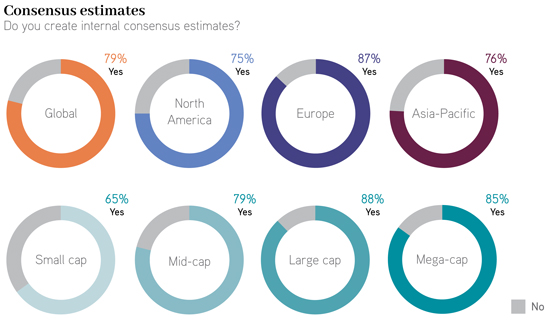New research highlights different regional practices among IR teams
Understanding market expectations is a critical part of the IR role. That’s why many IR teams compile their own internal sell-side consensus estimates. Not willing to rely on third-party providers, they review the figures each quarter or half-year and create their own averages, including or excluding certain forecasts as they see fit.
But how widespread is this practice? And to what extent do companies then publish their internal figures to the market? IR Magazine put these questions to more than 650 IR professionals as part of the research for its new research report: How to manage your sell-side coverage.
The findings show that four out of five companies (79 percent) on a global basis create their own internal consensus figures. European respondents are keenest, with 87 percent undertaking this activity, compared with 75 percent in North America and 76 percent in Asia-Pacific.

Across market caps, there is a clear trend for larger companies to be more likely to prepare internal consensus numbers. This is likely down to the increased resources at larger companies to either do it themselves or hire support from an external firm. After all, creating consensus numbers is a hugely time-consuming activity.
When asked whether they publish their consensus figures, company responses vary depending on where they are based. Almost half (47 percent) of European companies that produce internal consensus numbers say they release them to the market in some form. The most popular ways to do this are either via email or by listing them on the website. By contrast, just 9 percent of North America-based respondents publish their own consensus numbers.

The difference between Europe and North America is down to the different legal views on companies publishing analyst estimates. In the US, lawyers heavily frown on this activity as they believe publishing either individual forecasts or a consensus figure could amount to an endorsement of the analysts involved. The situation is much more relaxed in Europe, with companies free to use their own methodology to create consensus figures and then release them to the market.
The findings are included in the new report from IR Magazine: How to manage your sell-side coverage, which is available to Professional subscribers. Click here for more information on how to access the report.










